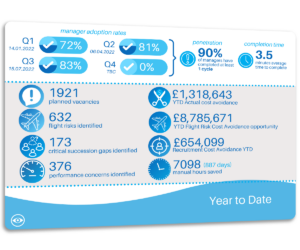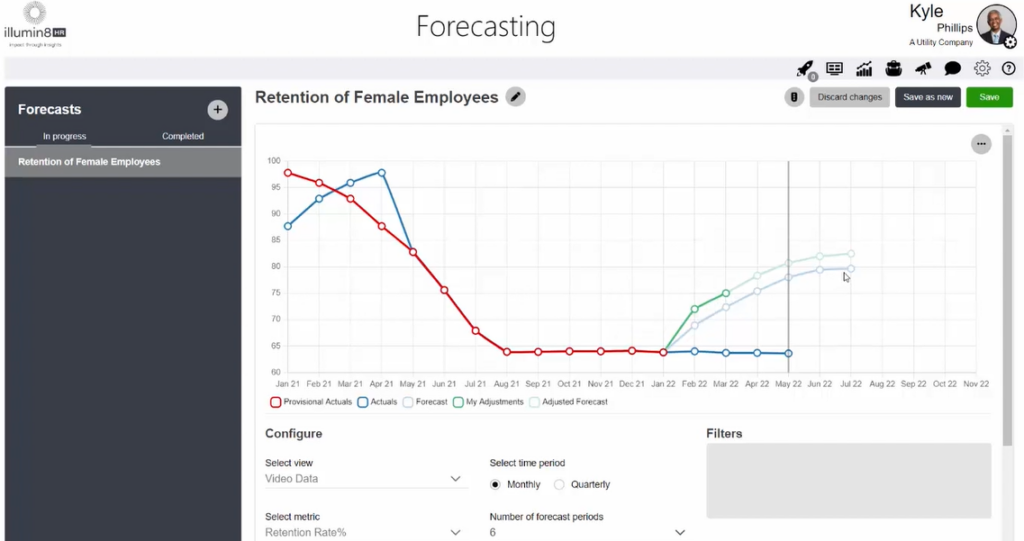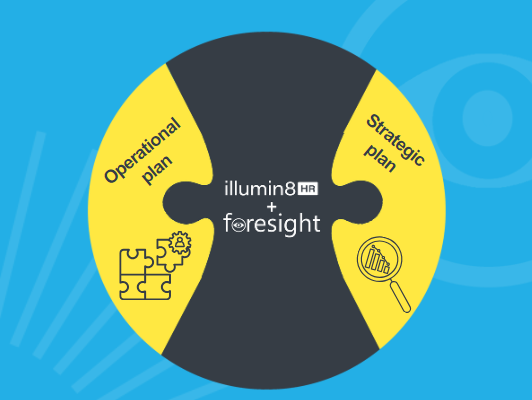5 min ⏱︎
Workforce planning is a critical component of a successful business strategy. It ensures that an organisation has the right people, with the right skills, in the right places, at the right times. In today’s rapidly changing business environment, a combination of operational and strategic workforce planning (SWP) is essential to support both short-term and long-term goals.
illumin8HR and Foresight are joining forces to deliver a transformational workforce planning solution, connecting the dots between operational and strategic workforce planning.
In an interview with the business leaders, Danny Hodgson, Kraig Payne and Heidi Lopez, we explore the benefits of an integrated approach and how illumin8HR and Foresight is a game-changer for workforce planning teams.
Let’s start with the typical challenges operational and strategic workforce planning (SWP) bring.
How would you explain these?
Danny: There are some common challenges with both.
The biggest challenge is often nothing more complicated than capacity issues. Everyone agrees: planning their recruitment is a no brainer but with huge volumes of hiring managers, how do we engage with all of them to have 1 central plan?
The other main challenge is we often over complicate it. We think we need managers to start predicating things. We really don’t. You’d be amazed at just how transformational all the known recruitment needs having -in one place is. Start off very simple and you (and your Finance Director) will be amazed at those results. Then build maturity over time.
Then we move onto SWP. This tends to be a more theoretical process. The business goals might stretch to 3, 5 or 10 years into the future. We have worked with one organisation recently who is looking 12 years ahead.
In essence, SWP is about making sure the organisation has the right people, knowledge and skills to deliver the strategic goals of the business. Once these goals are agreed, business leaders and senior management teams typically work with the SWP team to create a workforce model built on assumptions around growth (or decline), by business area, location, skill set, etc.
They’ll consider internal drivers that impact on workforce decisions like, the use of tech and process efficiency, org structures, the way products will be delivered, and so on, as well as external considerations, such as labour supply, future skills gaps, political changes, etc that have an influence on the shape of the future workforce. Those assumptions then inform decisions and estimates on what labour is needed where, the current baseline and the gaps, so plans and budgets can be created.
In reality of course, as soon as the plan is signed off, it’s out of date as external and internal forces change, and strategic goals and priorities shift around. So a key challenge is how you keep the plan evolving and join the dots with the in-year plan.
OK, so the recruitment team have the short-term plan and the SWP team have the long-term plan. And in between those, there are a bunch of budgeting models and assumptions. What happens then?
Kraig: Too often, the SWP will be dusted off once a year in planning rounds and adjusted so teams can ‘go again’. In the meantime, the organisation carries on executing the in-year recruitment plan whilst reacting to the changing business requirements.
We have heard some stories at this year’s People Analytics World about the drawbacks of companies using a rinse and repeat approach when it comes to SWP and the risks of not regularly validating the assumptions the plan is built on. Meanwhile, on the ground, when someone resigns, the typical response is to replace with like-for-like swap, without stopping to consider the long-term plan. If that happens year after year, you’re really in trouble.
Heidi: A good example we’ve seen recently was a global organisation that had grown through a series of acquisitions. Although they had a strategic workforce plan in place centrally, the day-to-day decisions on recruitment were local and reactive, and weren’t aligned to the long-term goals. Over time, this meant a growing in gap in what was needed vs what they had – these gaps take money and time to close.
The solution was two-fold. The planners needed people data from each location to constantly test the planning assumptions and bring the day-to-day decisions into line. And they needed a regular and open dialogue with hiring managers to make any adjustments. This drove a cultural change in the way workforce planning was executed, ensuring one cohesive plan that aligned to the future goals.
So how do illumin8HR and Foresight help solve the issue?
In simple terms, we provide the technology to bring together 3 key pieces of the jigsaw – the people data, the process and the decision makers.
We combine all the real-time people data into one platform – retention, sickness, skills, development plans, contract types, recruitment activity, costs etc that impact the workforce plan. But that only tells part of the story. We also digitise conversations with hiring managers, regularly gathering the inside track on what changes they are expecting in their teams – who is at risk of leaving, what vacancy or skills gaps they are expecting, who is ready for development or promotion that fill any gaps, and so forth. That’s another layer of additional people intelligence that’s not in HR systems but allows recruitment and planning teams to stay a step ahead.
With this combined data in one place, the management teams and planners have full visibility of the gaps and are able to constantly validate the assumptions in the SWP so plans can be easily adjusted and shared in one cohesive platform.
The power of the data and insights captured through Foresight’s digital conversations with hiring managers, combined with all HR data constantly updating in the illumin8HR people analytics platform, makes this a truly unique solution to workforce planning.
What makes this a game-changing in workforce planning?
- People managers, HR teams and planners have access to all their people data in one place
- Regular digital conversations with people managers capture changing resource requirements
- Planning teams can constantly validate planning assumptions in a simple, time-efficient way
- Simple visuals and alerts flag resourcing gaps and trends that require action
- Plans can be shared and amended amongst across planning teams and managers
- Forecasting and scenario modelling tools can be shared and amended in one place
To find out more, book a short discovery call to discuss your workforce planning challenges and start safeguarding against workforce risks.






